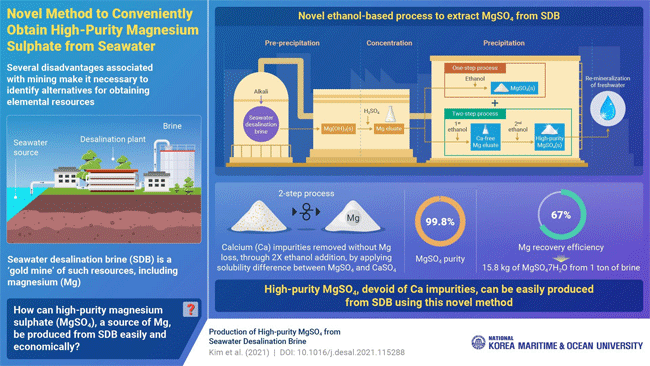[한국] 해양대, 해수담수화 염수서 고품질 황산마그네슘 추출 성공
한국해양대 환경공학과 김명진 교수팀 해수서 99.8%의 순수 MgSO4 추출

한국해양대학교(Korea Maritime and Ocean University) 환경공학과 김명진 교수가 이끄는 연구진이 바닷물에서 양질의 광물을 추출하는 데 성공했다. 특히 해수담수화 염수(SDB ; seawater desalination brine)에서 99.8%의 순수 황산마그네슘(MgSO4)을 추출할 수 있다.
연구 동기에 대해 김명진 교수는 “우리는 이미 세계의 물 필요를 해결하기 위해 정교한 해수 담수화 과정을 개발했으므로 그것을 광물 추출의 유익한 과정과 결합하는 것은 어떨까! 이렇게 하면 에너지 효율적이고 지속 가능하며 환경 친화적인 방법으로 추출이 이루어질 수 있을 것으로 믿는다”라고 말했다.
이 연구팀의 연구결과는 연구기사로 2021년 12월 15일 발행되는 『담수화 저널(the journal Desalination)』의 온라인 기사로 게재되었다.
또한, 연구팀은 두 공정을 결합했을 뿐만 아니라 황산마그네슘(MgSO4)을 추출하기 위한 새롭고 미묘한 에탄올 기반 공정을 개발했다. 초기에 연구원들은 염수(brine)에서 알칼리 기반 수산화마그네슘 침전, 황산 기반 마그네슘 농도와 같은 단계를 따랐다.
마지막으로, 마그네슘 용출액을 에탄올로 두 번 처리했는데, 첫 번째는 칼슘 불순물을 제거하고, 두 번째로 고순도가 높은 MgSO4를 침전시켰다.
흥미롭게도, 이 최종 2단계 공정은 최대 67%의 마그네슘 회수 효율을 달성하기 위해 에탄올에 함유된 마그네슘과 황산칼슘 사이의 용해도 차이를 사용했다.
SDB(해수담수화 염수)로부터의 광물 추출의 비용 효과 때문에, 연구원들은 얻어진 MgSO4가 담수화 담수를 다시 미네랄화하는 데 사용될 뿐만 아니라 제약 및 식품 산업에서도 잠재적인 응용 분야를 찾을 수 있다고 말한다.

김명진 교수는 “우리의 연구가 대체 광물 채취 과정에 대한 더 많은 연구를 장려하기를 바란다”고 덧붙였다.
실제로 인류는 그러한 과학의 도움으로 환경피해를 되돌리면서 지속적인 기술 발전에 대한 요구를 지속적으로 충족할 수 있기를 희망할 수 있다.
[원문보기]
Extracting high-quality magnesium sulphate from seawater desalination brine
Given that mining to extract high-grade mineral ores is wastefully energy intensive, exhaustible, and bad for the environment, scientists have been scouting for alternatives.
A group of Korean researchers, led by Professor Myoung-Jin Kim, from Korea Maritime and Ocean University, have now succeeded in extracting high-quality minerals from just seawater. Specifically, they have achieved the extraction of 99.8% pure magnesium sulfate (MgSO4), from seawater desalination brine (SDB).
Speaking about the motivation behind the study, Prof. Kim explains that "since we have already developed a sophisticated seawater desalination process to address the world's water needs, why not couple it with the beneficial process of mineral extraction! In this way, we believe that such extraction can be performed in an energy-efficient, sustainable, and environment-friendly manner."
The team's findings have been published online, as a research article, on 15th December 2021, in the journal Desalination.
Further, the team has not only coupled the two processes, but has also developed a novel and subtle ethanol-based process to extract MgSO4. Initially, the researchers followed steps such as alkali-based magnesium hydroxide pre-precipitation from brine, and sulfuric acid-based magnesium concentration.
Finally, they treated the magnesium eluate, twice, with ethanol?the first time, to remove calcium impurities, and the second time, to precipitate the high-purity MgSO4.
Interestingly, this final two-step process used the difference in solubility between magnesium and calcium sulfates in ethanol, to achieve up to 67% magnesium recovery efficiency.
Owing to the cost-effectiveness of mineral extraction from SDB, the researchers state that the obtained MgSO4 may not only be used for re-mineralizing desalinated fresh water, but also find potential applications in the pharmaceutical and food industry.
Prof. Kim adds that they "hope that our study encourages further research on alternative mineral extraction processes."
Indeed, humanity, with the aid of such science, can hope to reverse environmental damage, while sustainably meeting its needs for continued technological advancements.
[출처=phys.org(https://phys.org/news/2021-11-high-quality-magnesium-sulphate-seawater-desalination.html) / 2021년 11월 10일]

